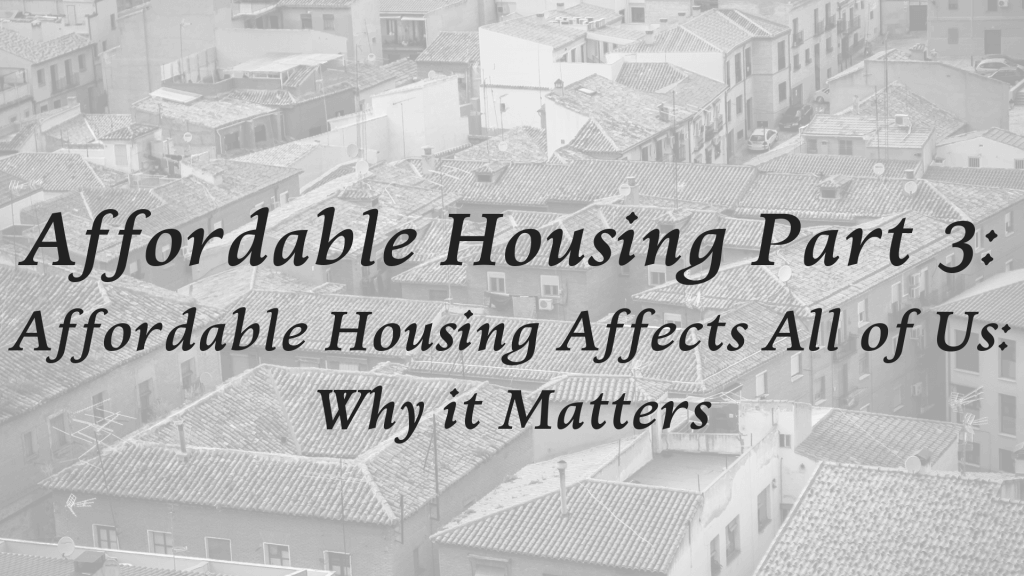Affordable Housing Part 3: Affordable Housing Affects All of Us
Maybe you aren’t cost-burdened. You don’t have to decide between paying the light bill or buying food. And neither do your friends or neighbors. Maybe you’re thinking this whole issue of affordable housing doesn’t affect you.
Think again.
A 2014 report by Enterprise Community Partners (here) should make us all pause and reconsider. The lack of affordable housing has measurable impacts on families, communities, and society overall. The report on housing instability, including homelessness, presents their findings by major issues; below is an excerpt of just three of these issues we can all relate to:
• Education — Housing instability/homelessness (HI/H) jeopardizes children’s performance and success in school and contributes to long-lasting achievement gaps. The stress of HI/H makes learning difficult; in addition, it disrupts school attendance, lowering students’ overall academic performance. Long-term academic success is directly impacted by housing stability.
• Health — HI/H has serious negative impacts on the health of children and adults. Problems include asthma, being underweight, developmental delays, and increases the risk of depression, to name a few. Affordable housing provides stability, freeing up resources for nutritious food and health care.
• Neighborhood Quality — The report states that “A number of national and regional studies have found that investments in affordable housing produce benefits in the form of jobs, local income, sales, increased property values and property tax revenues…” and “…Numerous studies show that affordable housing has a neutral or positive effect on surrounding property values…”
Let’s bring this closer to home. In October 2017 the Orlando Sentinel published the results of a study done by the Shimberg Center for Housing Studies at the University of Florida and Miami Homes for All, a South Florida nonprofit. The research focused on student homelessness; the Sentinel’s article (“Central Florida’s Homeless Students Top 14,000”) can be found here. According to the study, “…only 24 percent to 27 percent of homeless students passed assessment tests, while 40 percent to 48 percent of other students did.” They had higher rates of truancy and suspension, and “Even compared with students who live in poverty but are not homeless, the students whose families stay in shelters, cars, doubled up with another family or in extended-stay hotels fared significantly worse…” The Sentinel quotes Christina Savino, Orange County Public Schools senior administrator for homeless and migrant education: “…that lack of a stable home still really makes a difference.”
The lack of affordable, stable housing eventually ripples through all aspects of the local community and economy. While you might not be cost-burdened based on your income, your larger community, including the central Florida region as a whole, suffers when families are priced out of a stable place to call home.
 Your turn: Contact a local food pantry, teacher, community police officer, or health clinic and discuss the issues they see related to housing instability/homelessness. For example, ask the food pantry how hunger affects their clients’ choices on other critical needs; ask a teacher how hunger affects a student’s classroom behavior and academic progress; ask a local police officer how the lack of affordable housing affects crime; ask a health clinic about the impact of delayed medical attention on children and families. Who else might you discuss the topic with? Share your experiences with us!
Your turn: Contact a local food pantry, teacher, community police officer, or health clinic and discuss the issues they see related to housing instability/homelessness. For example, ask the food pantry how hunger affects their clients’ choices on other critical needs; ask a teacher how hunger affects a student’s classroom behavior and academic progress; ask a local police officer how the lack of affordable housing affects crime; ask a health clinic about the impact of delayed medical attention on children and families. Who else might you discuss the topic with? Share your experiences with us!


